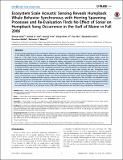| dc.contributor.author | Gong, Zheng | |
| dc.contributor.author | Tran, Duong | |
| dc.contributor.author | Yi, Dong Hoon | |
| dc.contributor.author | Wu, Fan | |
| dc.contributor.author | Zorn, Alexander | |
| dc.contributor.author | Ratilal, Purnima | |
| dc.contributor.author | Jain, Ankita Deepak | |
| dc.contributor.author | Makris, Nicholas | |
| dc.date.accessioned | 2014-10-20T13:39:39Z | |
| dc.date.available | 2014-10-20T13:39:39Z | |
| dc.date.issued | 2014-10 | |
| dc.date.submitted | 2012-12 | |
| dc.identifier.issn | 1932-6203 | |
| dc.identifier.uri | http://hdl.handle.net/1721.1/90982 | |
| dc.description.abstract | We show that humpback-whale vocalization behavior is synchronous with peak annual Atlantic herring spawning processes in the Gulf of Maine. With a passive, wide-aperture, densely-sampled, coherent hydrophone array towed north of Georges Bank in a Fall 2006 Ocean Acoustic Waveguide Remote Sensing (OAWRS) experiment, vocalizing whales could be instantaneously detected and localized over most of the Gulf of Maine ecosystem in a roughly 400-km diameter area by introducing array gain, of 18 dB, orders of magnitude higher than previously available in acoustic whale sensing. With humpback-whale vocalizations consistently recorded at roughly 2000/day, we show that vocalizing humpbacks (i) were overwhelmingly distributed along the northern flank of Georges Bank, coinciding with the peak spawning time and location of Atlantic herring, and (ii) their overall vocalization behavior was strongly diurnal, synchronous with the formation of large nocturnal herring shoals, with a call rate roughly ten-times higher at night than during the day. Humpback-whale vocalizations were comprised of (1) highly diurnal non-song calls, suited to hunting and feeding behavior, and (2) songs, which had constant occurrence rate over a diurnal cycle, invariant to diurnal herring shoaling. Before and during OAWRS survey transmissions: (a) no vocalizing whales were found at Stellwagen Bank, which had negligible herring populations, and (b) a constant humpback-whale song occurrence rate indicates the transmissions had no effect on humpback song. These measurements contradict the conclusions of Risch et al. Our analysis indicates that (a) the song occurrence variation reported in Risch et al. is consistent with natural causes other than sonar, (b) the reducing change in song reported in Risch et al. occurred days before the sonar survey began, and (c) the Risch et al. method lacks the statistical significance to draw the conclusions of Risch et al. because it has a 98–100% false-positive rate and lacks any true-positive confirmation. | en_US |
| dc.description.sponsorship | National Oceanographic Partnership Program (U.S.) | en_US |
| dc.description.sponsorship | Census of Marine Life (Program) | en_US |
| dc.description.sponsorship | United States. Office of Naval Research | en_US |
| dc.description.sponsorship | Alfred P. Sloan Foundation | en_US |
| dc.description.sponsorship | National Science Foundation (U.S.) | en_US |
| dc.description.sponsorship | Presidential Early Career Award for Scientists and Engineers | en_US |
| dc.description.sponsorship | Northeastern University | en_US |
| dc.description.sponsorship | Massachusetts Institute of Technology | en_US |
| dc.language.iso | en_US | |
| dc.publisher | Public Library of Science | en_US |
| dc.relation.isversionof | http://dx.doi.org/10.1371/journal.pone.0104733 | en_US |
| dc.rights | Creative Commons Attribution | en_US |
| dc.rights.uri | http://creativecommons.org/licenses/by/4.0/ | en_US |
| dc.source | Public Library of Science | en_US |
| dc.title | Ecosystem Scale Acoustic Sensing Reveals Humpback Whale Behavior Synchronous with Herring Spawning Processes and Re-Evaluation Finds No Effect of Sonar on Humpback Song Occurrence in the Gulf of Maine in Fall 2006 | en_US |
| dc.type | Article | en_US |
| dc.identifier.citation | Gong, Zheng, Ankita D. Jain, Duong Tran, Dong Hoon Yi, Fan Wu, Alexander Zorn, Purnima Ratilal, and Nicholas C. Makris. “Ecosystem Scale Acoustic Sensing Reveals Humpback Whale Behavior Synchronous with Herring Spawning Processes and Re-Evaluation Finds No Effect of Sonar on Humpback Song Occurrence in the Gulf of Maine in Fall 2006.” Edited by Z. Daniel Deng. PLoS ONE 9, no. 10 (October 7, 2014): e104733. | en_US |
| dc.contributor.department | Massachusetts Institute of Technology. Department of Mechanical Engineering | en_US |
| dc.contributor.mitauthor | Jain, Ankita Deepak | en_US |
| dc.contributor.mitauthor | Yi, Dong Hoon | en_US |
| dc.contributor.mitauthor | Makris, Nicholas | en_US |
| dc.relation.journal | PLoS ONE | en_US |
| dc.eprint.version | Final published version | en_US |
| dc.type.uri | http://purl.org/eprint/type/JournalArticle | en_US |
| eprint.status | http://purl.org/eprint/status/PeerReviewed | en_US |
| dspace.orderedauthors | Gong, Zheng; Jain, Ankita D.; Tran, Duong; Yi, Dong Hoon; Wu, Fan; Zorn, Alexander; Ratilal, Purnima; Makris, Nicholas C. | en_US |
| dc.identifier.orcid | https://orcid.org/0000-0002-0261-4482 | |
| dc.identifier.orcid | https://orcid.org/0000-0003-4369-296X | |
| mit.license | PUBLISHER_CC | en_US |
| mit.metadata.status | Complete | |
